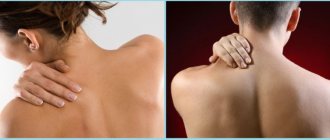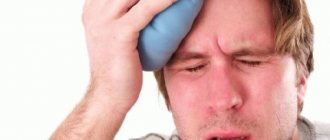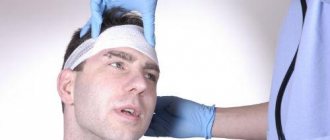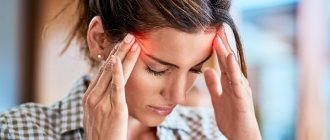Possible causes, associated symptoms
It’s hard to argue, but a headache is an unpleasant condition that can exhaust a person. The sensations can vary significantly: they can be easily eliminated by taking certain medications, or they can intensify, regardless of the measures taken. However, there are a number of situations when a simple pill is far from enough; you have to resort to more radical methods, the need for which is determined by the doctor after a thorough examination.
It's worth knowing why it's really important to see a doctor immediately if:
- balance is disturbed, up to complete disorientation;
- burning pain;
- vision deteriorates sharply;
- very dizzy;
- pressure drops are observed;
- vomiting begins;
- a person loses memory;
- temperature rises;
- the mucous membrane in the mouth dries out;
- painful to touch.
It is also strictly forbidden to endure if you have a headache in the crown area; painkillers do not help. Situations are increasingly common where the main cause is constant stress, chronic fatigue, insufficient rest, and a busy work schedule. Moreover, oxygen deficiency cannot be discounted.
Headache in the parietal part of the head, causes, along with those listed above, also belong to the risk group:
- physical fatigue;
- unbalanced diet;
- bad habits;
- arterial type hypertension;
- pathological deviations of the cervical area, causing circulatory problems.
For situations when the head begins to hurt from above, with pressing sensations spreading along the back of the head, sides, like a hat, while there is noise in the ears, there is reason to assume an increase in pressure, the pulse may become shorter.
Quite often, such conditions are accompanied by numbness in the occipital region, due to which a person completely involuntarily strains the muscles of the neck, which further increases the discomfort, making it impossible to touch.
Let us immediately note that for patients who have pain in the parietal part of the head, the causes are usually the psycho-emotional stress they experience on an ongoing basis.
The only correct solution to cope with such a situation is proper rest and maximum attention to your own health.
It is also important to learn to abstract yourself from problems that cause stress.
Things are much more serious when the disease is a consequence of a head injury.
The most common signs accompanying unpleasant sensations in the parietal part are:
- dizziness, especially when bending sharply;
- rapid pulse;
- compression of the temples in the middle;
- severe weakness.
All this is clear evidence of the presence of serious disorders in the body, which should be identified as quickly as possible with subsequent treatment.
Although it is worth noting that it is enough to get a sore throat, a cold, a cough, a bad tooth, this can also cause unpleasant sensations throughout the body, and not just at the top - the head: the ear shoots, the nose runs, as if the throat is “burning”.
Origin of spasms in the parietal region of the head
If a person feels pain in the top of the head, there can be many different explanations for this. To eliminate unpleasant discomfort, it is necessary to undergo an examination, based on the results of which a therapist will diagnose and prescribe adequate treatment.
If the patient has pain and throbbing in the top of the head, then this may indicate the presence of the following pathologies:
| Causes of discomfort, spasms | Symptoms, features of the course |
| Stress and overexertion | Constant physical activity and fatigue can cause spasms in the upper part of the head. Moreover, discomfort appears not only after playing sports or excessive activity: prolonged sitting in an incorrect position also causes muscle fatigue. Through pain, the body signals that it is already at its limit. With stress and depression, the following may occur:
The best way to eliminate discomfort is proper rest, walks in the fresh air, yoga and relaxation, calm, quiet music. |
| Various brain and skull injuries | Post-traumatic syndrome causes discomfort in the parietal part of the head. Spasms can be acute or chronic, appearing only two weeks after the injury. Often, such symptoms are present in the presence of hidden pathology. Therefore, it is recommended to consult a specialist if the following conditions occur:
|
| Osteochondrosis of the cervical-collar area |
|
| Hypertension | High blood pressure often accompanies pain in the crown area. The disease can cause hemorrhage, so if you have characteristic symptoms, you should consult a specialist:
|
| Neoplasms | What causes pain and throbbing on the top of the head and the main causes of this syndrome:
Character of symptoms:
|
| Migraine |
Headache, spasms in the crown area and the main causes of its occurrence lie in degenerative disorders of the nervous system, when there is a deficiency or excess of substances necessary for the body in the blood. |
Advice from neurologists: how to avoid the development of cluster and point pain
A list of simple recommendations that will help prevent the development of migraines of any etiology and diseases that provoke them:
- You need to sleep at least eight hours every night. no matter what problems the patient may be experiencing, no matter what stress he may be experiencing, a good night’s sleep should be a must.
- Good nutrition is the basis of a healthy nervous system. Under no circumstances should you adhere to strict diets and starve yourself - even if the consequences do not appear immediately, they will come over time (the nervous system exhausted by fasting does not forgive such an attitude).
- A sufficient amount of amino acids, vitamins and microelements in the diet.
- The correct reaction to stress is to remain calm in any situation, so that later you don’t think about why your head hurts (the back of your head, the crown or your forehead).
- Moderate physical education - do not exhaust yourself with exercises, do not provoke overwork.
If the skin on the crown of your head hurts
Sometimes a condition arises in which painful sensations are concentrated on the skin of the crown and appear at the moment of touching the hair. This feeling occurs in the following situations:
- allergies to hair care products;
- tight hairstyle or too heavy hair;
- fungal disease of the scalp;
- psoriasis of the scalp;
- spasm of blood vessels surrounding and feeding the hair follicles.
These are the main reasons why the scalp on the top of your head hurts, and you can take the following steps to relieve or stop the pain:
- Stop using products that cause allergies, apply a soothing bread mask to the scalp or rinse with chamomile infusion.
- Change your hairstyle - instead of a high tight bun or ponytail, try fashionable French braids, and be sure to let your hair down at night.
- Consult a trichologist for fungal treatment.
- Take maximum care from factors that provoke the occurrence of psoriasis - reduce psycho-emotional stress, stick to a diet.
- Do not overheat or overcool the scalp.
A headache in the top of the head can occur from overexertion, or can be a harbinger of serious illnesses. Prolonged or recurring pain is a serious reason to seek advice from a specialist.
Constant headaches are a common occurrence in modern city life. At the same time, occupation, age, gender and other factors do not affect the manifestation of headaches. Impaired memory, vision, speech, dizziness and nausea may also be symptoms of a problem. If you have a headache for 5 or 40 days, you should undergo a serious examination, as such a symptom may indicate serious health problems. Serious examinations include CG, ultrasound, ECG, Echo, blood test, CT, MRI and many others.
The relationship and difference between point pain and regular migraine
Point cephalalgia is often a component of other types of headaches:
- “Tension pain” is a concept in neurology that arose a long time ago and is still relevant today. It occurs in both men and women due to severe nervous and physical fatigue. It is expressed not only in point cephalgia, but also in the fact that the forehead and back of the head hurt (the localization and nature of the pain changes on average once an hour). At the same time, the patient feels nausea, dizziness, and may lose consciousness. A good night's sleep is often enough to stop these symptoms. If the patient is unable to fall asleep on his own, he should resort to taking a sleeping pill.
- Histamine pain. In 40% of cases it is associated with pain of a primary nature. One type of migraine can act as a harbinger of another and change the patient’s condition. For example, the condition begins as a migraine with aura, and after an hour it develops into an ophthalmoplegic form.
- Cranialgia is a condition that occurs when the trigeminal nerve becomes inflamed. This is a common reason why the back and top of the head hurt. Cranialgia is characterized by lumbago in the form of short-term impulses. Most often, this condition does not require any special treatment and goes away after the inflammatory process of the trigeminal nerve stops.
What tests are usually prescribed?
At an appointment with a neurologist, a physical examination of the patient is performed: basic neurological reflexes are checked and the neck muscles are examined.
The doctor writes out a referral for tests: general blood test, biochemical blood test, blood sugar test.
A general blood test with an increase in ESR or an increased content of leukocytes indicates inflammation in the body.
Blood biochemistry may indicate a deficiency of one of the vital elements, which leads to discomfort in the head area.
Low blood glucose levels are often accompanied by cephalgia, dizziness and weakness.
The doctor may write a referral for additional tests:
- The gas composition of arterial blood can reveal cerebral hypoxia.
- A blood test for hormones determines various abnormalities in the functioning of the hypothalamus.
A neurologist can give a referral to one or more diagnostic methods:
- Magnetic resonance imaging (MRI) - excludes the presence of various neoplasms (tumors and cysts), aneurysms. The photographs clearly show post-traumatic defects, neurodegenerative abnormalities, and changes in blood vessels affected by atherosclerosis.
- Computed tomography (CT) is the most informative method for studying the brain. It gives a clear idea of pathological changes in the skull and brain, pathology of bone tissue, blood vessels and brain structures. Provides information about the consequences of traumatic brain injuries. The disadvantage of this method is the significant radiation dose during the study.
- Electroencephalography gives an idea of the presence of pathological changes in blood vessels and impaired cerebral circulation.
- Doppler ultrasound (ultrasound of the vessels of the head and neck) - shows the presence of atherosclerotic plaques in the arteries; narrowing and tortuosity of the arteries, leading to brain hypoxia; peripheral vascular resistance.
- Rheoencephalography (REG) - gives an idea of the tone and blood flow of blood vessels. Using REG, the following are diagnosed: hypertension, atherosclerosis, vegetative-vascular dystonia.
- MRI of the cervical spine - the presence of cervical osteochondrosis can cause pain in the head and neck, which intensifies when turning the head.
- Rheovasography of cerebral vessels (RVG) - shows the quality of blood flow through the great vessels, evaluates collateral circulation.
- Radiography will be less known. In the image you can only see the bone structures of the skull, soft tissues are not visible.
There is no need to panic when scheduling such a serious examination. The doctor excludes rare severe pathologies and looks for the causes of the pain process.
Based on the studies, if no serious organic lesions are found, the cause of the disease is usually diagnosed. It develops as a result of: vascular spasms, cerebral hypoxia, hypertonicity of cerebral vessels, hormonal imbalances, vegetative-vascular dystonia or osteochondrosis, provoked by physical or psycho-emotional stress.
A harbinger of serious illness
Cluster cephalgia, in which the patient constantly experiences pinpoint throbbing pain in the right side of the head, may indicate the development of the following diseases and conditions:
- brain tumors of various origins;
- withdrawal state;
- aneurysms;
- hematomas due to traumatic brain injuries and concussions;
- poisoning with certain drugs;
- taking vasodilators (for example, nitroglycerin) or histamine.
Diagnosis and treatment of headaches
To determine the true causes that provoked cephalalgia, patients are usually referred for consultation to a neurologist, ophthalmologist, psychiatrist, or traumatologist. In addition, the following examinations are mandatory:
- general blood and urine analysis;
- ECT of the heart;
- MRI and CT of the brain;
- X-ray of the cervical spine;
- measure blood pressure.
As a result of the examination, a complete clinical picture is collected, on the basis of which a diagnosis is established, followed by treatment tactics.
In addition to the cause of cephalgia, age, gender and the individual characteristics of each organism are also important for the choice of therapy.
Treatment of primary pain mainly involves the use of special medications, adherence to a regimen, and performing relaxation and physiotherapeutic procedures.
The choice of medications for headaches is quite extensive. For low blood pressure, Citramon and Askofen are prescribed; for high blood pressure, Captopril and Farmadipin are prescribed.
When a patient suffers from migraines, it is imperative to take a vitamin-mineral complex.
For cluster pain, Sedalgin is effective.
Also, for severe dull pain, Spazmalgon, Ibuprofen and others are prescribed
With secondary cephalgia, treatment should primarily be aimed at eliminating the cause, and the use of painkillers is purely concomitant in nature to relieve painful symptoms.
However, one rather important rule should be remembered and strictly observed: self-medication is strictly prohibited, all medications must be prescribed by a doctor and a strict dosage must be established. https://www.youtube.com/embed/FACeP1e2tAg
Treatment
Conservative therapy
Therapeutic tactics are determined by the nature of the pathology that provoked the appearance of the symptom:
- Cerebrovascular disorders
. Medicines to improve blood rheology, acetylsalicylic acid, and neurometabolites are indicated. If blood pressure increases, it is recommended to administer medications with antihypertensive effects. During the recovery period, therapy with sedatives is carried out. - Intracranial hypertension
. A combination of diuretics with potassium supplements is effective. Neurometabolites are useful. Depending on the etiology of the disease, antibiotics, venotonics, and detoxification agents are prescribed. - Inflammatory pathologies of the central nervous system
. The basis is antimicrobial drugs (antimicrobial or antiviral). Vitamins, neuroprotectors, neurometabolites are used, and symptomatic therapy is carried out. Treatment of arachnoiditis is carried out using antiallergic, antiepileptic, and hormonal drugs. - Traumatic injuries
. TBI requires NSAIDs, antibiotics, neurometabolites, and nootropics. In case of spinal injuries, immobilization is performed and medications are prescribed to stimulate metabolic processes in the nervous tissue. - Otolaryngological diseases
. In most cases, the main treatment method is antibiotic therapy. Treatment regimens are supplemented with vitamins, anticongestants, antihistamines, and local antiseptics. For sinusitis, lavages and punctures are performed, and a pit catheter is installed. - Radicular syndrome
. They use painkillers, anti-inflammatory, vascular, decongestants, chondroprotectors of general and local action. Absorbable therapy and drug blockades are carried out.
Surgery
Patients with pain in the crown undergo the following surgical interventions:
- Intracranial hypertension
: decompressive craniotomy, various shunting methods, external ventricular drainage. - Traumatic injuries
: operations for depressed skull fractures, fixation of vertebrae. - Otolaryngological diseases
: traditional and endoscopic frontotomy, polysinusotomy, mastoidotomy, myringotomy, bypass of the tympanic cavity, sanitizing surgery on the middle ear.
Why does pain occur?
It must be said that the main reasons for the development of vertex cephalgia may lie in excessive physical (muscular) tension or chronic fatigue of the body.
In addition, quite often this part of the skull can become intensely painful due to powerful stressful situations experienced by the patient.
Unfortunately, no one can be immune from cephalgia of the vertex region, neither office workers who spend their working day behind a computer monitor, nor athletes who undergo significant physical activity, nor the elderly, nor children.
And all because every modern person, as a rule, leads a fairly active lifestyle and is periodically exposed to stress, fatigue or lack of sleep.
Tension cephalalgia with localization in the vertex region is characterized by a somewhat pressing or compressive nature, beginning in the occipital region and subsequently moving literally throughout the entire head.
The main reasons for the development of such cephalgia can be concluded:
- In chronic fatigue of the body;
- Not quite healthy (often unhealthy) nutrition;
- Muscle strain;
- The presence of harmful or even dangerous habits to health - smoking, alcohol abuse.
However, vertex cephalgia is not always caused by such harmless causative factors; unfortunately, sometimes the causes of such ailments can be much more serious. Why else might a headache of this localization occur?
As it turns out, vertex cephalgia can often occur as a result of long-term untreated (progressive) hypertension.
However, in this case, the nature of the pain will be somewhat different. Ailments associated with increased blood pressure are usually pulsating and quite protracted.
And these are not all the answers to the question: why does cephalgia of the crown of the head develop. The cause of the described problem may well be compression of the spinal roots (nerves) located in the cervical spine.
In addition, the described symptoms of cephalalgia may well also have diseases such as:
- Cerebrovascular accidents, including stroke;
- Frontal sinusitis, otitis media, sinusitis, acute respiratory diseases;
- Neuritis of the occipital or facial nerve;
- Some endocrine diseases.
- Eye diseases;
- Brain tumors.
You must understand that it is sometimes not possible to independently understand the causes of cephalalgia, since the patient is often unable to objectively assess the degree of intensity of pain.
For example, sometimes an incredibly emotional patient experiencing migraine or tension cephalalgia may claim that her head is literally exploding. At the same time, some patients may suffer a stroke on their legs, claiming that their head hurt just a little.
Patient Vladimir, 40 years old. The man was taken to the hospital at the insistence of his wife, a nurse by training. According to the patient, “the top of his head ached quite a bit, he could take analgin and go to work.”
However, his wife noticed the unsteadiness of his gait and the distortion of his smile on the left side and called an ambulance. After a detailed examination, the patient was diagnosed with a transient cerebrovascular accident and a high risk of stroke. The patient was prescribed full hospital treatment.
Patient Larisa, 56 years old. The woman complained of excessively intense headaches in the vertex area. The patient assured that cephalalgia was almost impossible to tolerate due to its excessive intensity.
After consulting a psychoneurologist, it turned out that the woman suffers from migraine-like conditions and periodically undergoes treatment in the department of borderline conditions of the psychoneurological dispensary. The patient was prescribed adequate treatment with sedatives.
Most common reasons
Among the many factors mentioned above, there are causes of pain in the top of the head that are particularly common and have the most specific manifestations.
Occupational pain or tension pain
Both children and adults are susceptible to this type of headache, which most often affects the crown of the head. A dull pain presses on the head from above, compresses it and absorbs it entirely. There is a feeling as if an invisible helmet, helmet or spacesuit is being worn on top. The nature of occupational pain lies in the fact that a person remains in an uncomfortable position for a long time, without moving, in the presence of poor lighting, or in the workplace not meeting ergonomic standards and requirements.
Solution:
- Change working conditions - adjust the height of the chair, adjust the lighting, position the computer at the correct distance from the eyes.
- After every hour of work, get up from the table and do a little exercise, stretching your neck and shoulders.
- Regularly ventilate the room, maintain normal humidity and temperature.
- Perform a light self-massage of the head.
During the week, a person spends most of his time at work. To avoid headaches in the workplace, you need to properly organize your work-rest schedule and create suitable working conditions.
Neuroses and psychoemotional disorders
Over half of the complaints about pain that occurs where the crown of the head is located in a person is associated with neurotic diseases and disorders. If a squeezing or constricting headache occurs, often accompanied by dizziness and even numbness of the limbs, then this is a serious reason to consult a specialist.
Take care of your nerves. They cause most diseases
Approximately 60% of people diagnosed with neurasthenia or hysteria suffer from pain in the upper part of the head. Painful sensations are constant or periodic, they can intensify or weaken, but they always accompany the patient and do not leave him for a long time.
A person suffering from neurosis experiences emotional instability and is prone to panic attacks, and the fear is always very specific. Someone is afraid of getting a certain disease, someone is worried that they might lose a loved one, etc.
Unfortunately, a person with a neurotic disorder is constantly in a vicious circle of “fear-pain”. Fear increases pain, and pain causes new fears. Most often, people who experience prolonged stress or psycho-emotional stress suffer from neuroses.
Solution: seek help from a psychotherapist or psychiatrist and undergo a course of medication.
Post-traumatic conditions
People who have suffered even minor traumatic brain injuries complain that the top of their heads hurts. At the same time, there is a decrease in memory, performance, concentration and an increase in psycho-emotional exhaustion. The nature of such pain is dual in nature: physiological and psychosocial.
Physiological manifestations of pain are determined by the following factors:
- disturbance of the movement of cerebrospinal fluid;
- compression of the nerve roots;
- excessive pressure on the membranes of the brain.
The psychosocial component consists of increased suspiciousness of the victim, fear of complications after injury, and mistrust of doctors.
Solution: treatment from specialized specialists and consultation with a psychologist.
Vascular pain
Often the parietal area of the head suffers from pain that occurs with hypertension, hypotension, and vegetative-vascular dystonia. Decreased or increased vascular tone prevents them from performing their functions of maintaining optimal blood pressure. Either compression of the nerve cells by the vascular walls or vasospasm occurs.
- Equalizing blood pressure with medications prescribed by a doctor.
- Dieting.
- If the pain takes you by surprise, then people with high blood pressure need to lie down in bed and put a high pillow under their head, and people with low blood pressure need to put it under their feet.











